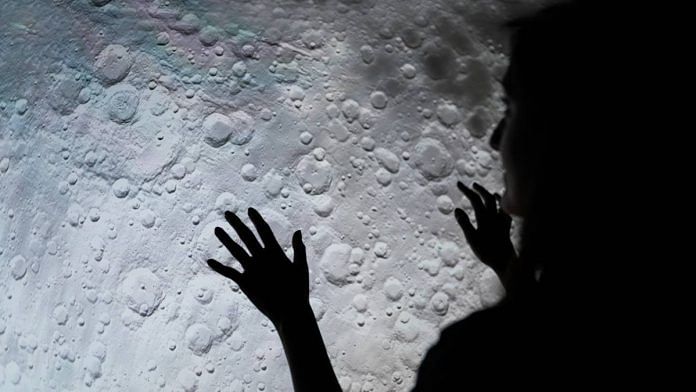Bengaluru: NASA’s Stratospheric Observatory for Infrared Astronomy (SOFIA), the world’s largest airborne observatory in the form of a Boeing 747SP carrying a reflecting telescope, has observed an unmistakable signature of water on the Moon, including on sunlit parts which was previously thought unlikely.
Hydration was first observed at the lunar South Pole by the Chandrayaan-1 mission in 2008. However, on sunlit parts, findings confirmed the presence of hydroxyl ions (OH) in minerals. This is the first finding to confirm molecular water (H2O) directly in parts of the Moon that are exposed to sunlight.
This detection of molecular water and its potential micro reservoirs was reported in two papers in Nature Astronomy, published Monday.
Also read: Ancient Moon’s magnetic field shielded Earth from solar radiation
Lunar cold traps
It is thought that water ice is trapped permanently in the shadowed regions of the lunar poles, which are perennially shielded from sunlight. Because there is no atmosphere for thermal regulation, parts of the Moon that are not exposed to the Sun are at temperatures below freezing point.
Water is unstable on the lunar surface when exposed to the Sun because of high temperatures, as well as quick disintegration when exposed to light. However, planetary scientists, data from NASA’s Lunar Reconnaissance Orbiter (LRO), and thermal modelling indicate that water might be trapped in the form of ice in many shadowy parts of the moon as well as sunlit areas.
Such ‘cold traps’ were predicted and subsequently confirmed on other celestial bodies such as Mercury, the innermost planet in our solar system, and the dwarf planet Ceres. The new findings also indicate that these emission lines, which are observed at higher latitudes (poles) are the “result of local geology” and “not a global phenomenon”, the authors — led by Paul Hayne of University of Colorado, Boulder — describe in one of the papers.
Hayne’s team analysed possible cold traps ranging from 1 km to less than 1 cm, and found that smaller, ‘micro’ traps occur hundreds to thousands of times more frequently than larger ones all over the lunar surface.
The authors argue that approximately 40,000 km² of the lunar surface has the capacity to store water in the form of these micro traps.
Also read: Sisir Kumar Mitra — Indian physicist with a crater named after him on moon
Confirmation of water
SOFIA observed the Moon on 31 August 2018 at the 6 µm band, a wavelength at which the spectral signature of water is not confused for hydroxyl, unlike the 3 µm band used by previous spacecraft that have confirmed hydroxyl. At 3 µm, it is not possible to distinguish between hydroxyl ions and molecular water.
The observations were made with FORCAST — the Faint Object infraRed CAmera for the SOFIA Telescope onboard the aircraft, which is the only instrument that can look for water at the 6 µm band. These observations confirm that previously detected hydrogen on the sunlit parts of the Moon is actually hydrogen in water molecules.
A group led by Casey Honniball of the University of Hawaii, was able to observe water in concentrations of 100 to 400 parts per million at high southern latitudes. This water was detected as vapour, and the authors state that it likely came to be on the lunar surface either by the reaction of solar wind or charged particles from the sun with the lunar soil or through water-laden meteorite impacts.
However, how the water was formed, what form it is in inside these glass beads, how it came to be, and how much water is present is still unclear, said the scientists at a media briefing on Monday.
Often, meteorite impacts with high energy melt a part of the Moon’s crust, reforming as glass and potentially trapping water within, with no means of escape. It is thought that upto 30 per cent of the lunar soil or regolith consists of glass samples, with the rest made up of rock and mineral fragments.
Also read: The Moon is rusting, and that shows how much we still don’t know about it
Why the findings matter
The new findings imply that water can be trapped on the Moon in a more widespread manner than previously thought. It could enable future missions to the Moon to more effectively tap into this resource on a more global scale, at any location, rather than struggle to reach trapped water at the difficult-to-reach poles.
There are currently four missions active on or around the Moon. These include two orbiters — NASA’s LRO and India’s Chandrayaan-2 — as well as two landers, China’s Chang’e 3 and 4. Chang’e 4 became the first spacecraft to land on the far side of the Moon, and deployed the Yutu-2 rover that is currently operational on the Moon.
China is planning the Change’e 5 sample return mission for later this year. India is planning to send the Chandrayaan-3 with a landing demonstrator next year, while the US, the UK, Japan, South Korea, Russia, and the UAE currently plan to send orbiters and landers to the Moon.
The US and Russia are also planning independent missions to the Moon within the next decade as part of their Artemis and Orel programs, respectively.
SOFIA will continue to observe the Moon and try to understand the prevalence and quantity of water in the near future, said the scientists.
Also read: Building thick houses & eating tomatoes: The unexpected realities of living on the moon






